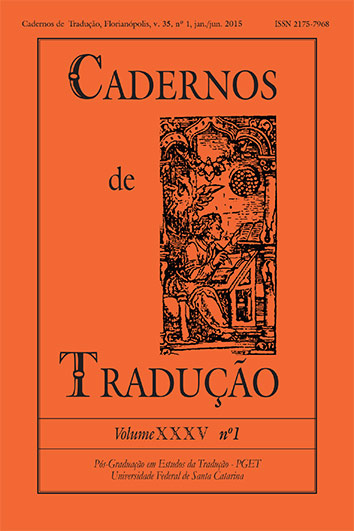Primeiros passos em busca de um corpus paralelo bilíngue voltado para o tratamento da ambiguidade
DOI:
https://doi.org/10.5007/2175-7968.2015v35n1p225Resumo
O processo de tradução de uma língua para outra, seja executada por humanos ou por máquinas, tem sido um desafio constante para pesquisadores em todo o mundo. Partindo do princípio de que a tradução não é simplesmente a substituição de uma palavra na língua de origem para outra língua, supostamente semelhante ao original, especialistas reconhecem que, além do conhecimento linguístico, o tradutor deve considerar o cenário de realização numa e noutra línguas. Apresentamos aqui alguns resultados preliminares obtidos a partir da investigação que vimos desenvolvendo em relação a esse assunto. Mais especificamente, com o foco no fenômeno de ambiguidade lexical, trazemos para debate uma breve discussão a respeito do problema. Tais resultados nos têm servido de base importante para a construção de um corpus paralelo bilíngue que se encontra em desenvolvimento por nossa equipe de trabalho, com vista à implementação futura de um dicionário bilíngue eletrônico, já em fase de análise e estudo de viabilidade para a especificação e modelagem.
Referências
Aitchinson, J. (1994). Words in the Mind: an introduction to the mental lexicon. Blackwell.
Alonge, A., Calzolari, N., Vossen, P., Bloksma, L., Castellon, I., Antonia, M., Marti, M. A., & Peters, W. (1998). The linguistic design of the EuroWorNet database. In Computers and the Humanities, 32:91-115. Dordrecht: Kluwer Academic Publishers.
Aristotle. (1984). Rethoric and Poetics of Aristotle (Modern Library College). McGraw-Hill.
Baker, M. (1999). Linguistic and Cultural Studies. Complementary or Competing Paradigms in Translation Studies? A. Lauer et al. (eds.), Ubersetzungswissenschaft im Umbruch, Tubingen: Gunter Narr.
Baker, M. & Malmkjaer, K. (2001). Routledge Encyclopedia of Translation Studies. London, New York: Routledge.
Barbosa, H.G. (2004). Procedimentos técnicos da tradução – uma nova proposta. Campinas, SP: Pontes.
Bentivogli, L; Pianta, E. Pianesi, F. 2000. Coping with lexical gaps when building aligned multilingual wordnets. In: International Conference on Language Resources and Evaluation - LREC, 2, 2000, Athens. Proceedings. (http://multiwordnet.itc.it/english/pubb.php).
Bidarra, J. (2004). O léxico no processamento da Linguagem Natural. Cascavel: Edunioeste.
Campos, G. 1986. O que é tradução. Coleção Primeiros Passos – 166 Leituras Afins. SP: Editora Brasiliense.
Catford, J.C. (1965). A Linguistic Theory of Translation: An essay in Applied Linguistics. London: Oxford Press.
Cruse, D.A. (2004). Meaning in language: an introduction to semantics and pragmatics. Oxford: Oxford University Press.
_____. (1986). Lexical Semantics. NY: Cambridge University Press.
Di Felippo, A. e Dias-da-Silva, B.C. (2009). A interlíngua da base lexical bilíngue REBECA. Veredas On-Line: Linguística de Corpus e Computacional, 2: 50-67, PPG Lingüística/UFJF.
Frazier, L. 1990. Exploring the Architecture of the Language-Processing System. G.T.M. Altman (Ed.). Cognitive Models of Speech Processing, 409-433. Cambridge: The MIT Press.
Gibbs, R.W., Beitel, D., Harrington, M., & Sanders, P. (1994). The Poetics of Mind. Figurative Thought, Language, and Understanding. Cambridge: Cambridge University Press.
Jakobson, R. (1975). Linguistica e Comunicação. São Paulo: Cultrix.
Lakoff, G. (1987). Women, Fire, and Dangerous Things: What Categories Reveal about the Mind. Chicago: The University of Chicago Press.
Kilgarriff, (1997). A. I don´t believe in word senses. Computers and the Humanities, 31 (2): 91-113.
Lehrer, A. (1974). Semantic Fields and Lexical Structure. North-Holland Linguistic Series (11). American Elsevier.
Nida, E. (1964). Toward a Science of Translation. Leiden: Brill.
Newmark, P. (1981). Approaches to Translation (Language Teaching Methodology). Elsevier Science & Technology.
Perini, M.A. 2003. Sofrendo a gramática. 3ª ed., São Paulo: Ática.
Pustejovsky, J. (1995). The Generative Lexicon. Cambridge: The MIT Press.
Quadros, R.M., Souza, S.X. (2008). Aspectos da tradução/encenação na Língua de Sinais Brasileira para um ambiente virtual de ensino: práticas tradutórias do curso de Letras Libras. In: R.M. Quadros (ed.). Estudos Surdos III. Petrópolis: Arara Azul.
Rosch, E. (1973). Natural categories. Cognitive Psychology, 4: 328-350.
Silva, A.S. (2006). O Mundo dos Sentidos em Português: Polissemia, Semântica e Cognição. Coimbra: Edições Almedina.
Sinclair, J. 1991. Corpus, Concordance, Collocation. Oxford University Press.
Taylor, J.R. (1985). Linguistic Categorization: prototypes in linguistic theory. Oxford: Clarendon Press.
Ullmann, S. (1979). Semantics: An Introduction to the Science of Meaning. Rowman&Littlefield.
_____. (1951). The Principles of Semantics. Oxford: Blackwell.
Vinay, J.P., & Darbelnet, J. (1977). Stylistique Comparée du Français et de l'Anglais. Paris: Didier.
Vygotsky, L.S. (1986). Thought and Language. Newly revised by Alex Lozulin. The Massachusetts Institute Technology.
Vossen, P., Marinai, E., Peters, C., Castellon, I., Marti, A., & Rigau, G. (1998). Compatibility in interpretation of relations in EuroWordNet. Computers and the Humanities, 32:153-184. Dordrecht: Kluwer Academic Publishers.
Downloads
Publicado
Como Citar
Edição
Seção
Licença
Autores têm autorização para assumir contratos adicionais separadamente, para distribuição não exclusiva da versão do trabalho publicada nesta revista (ex.: publicar em repositório institucional ou como capítulo de livro, com reconhecimento de autoria e publicação inicial nesta revista).





















































